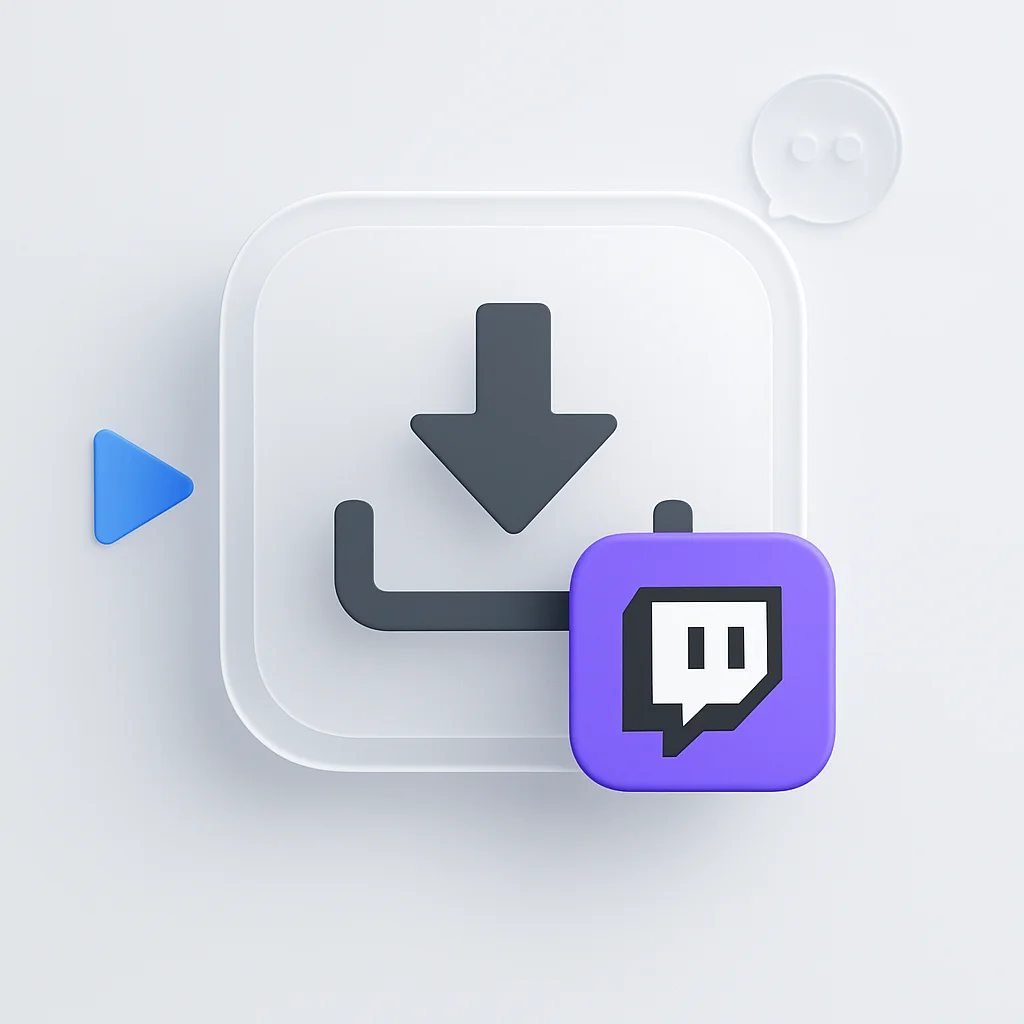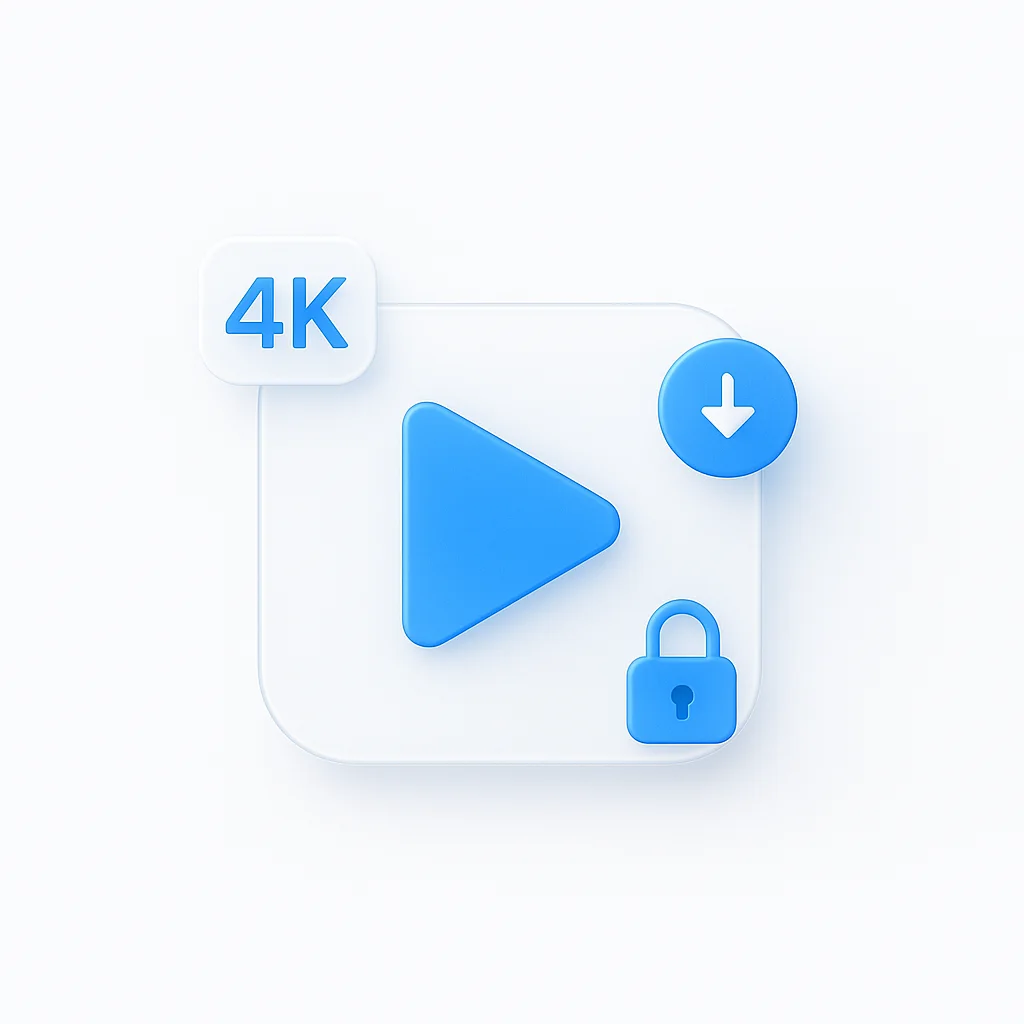Zooms neuer KI-Assistent ist ein leistungsstarkes Tool, das Ihnen helfen kann, Ihre Produktivität, Zusammenarbeit und Fähigkeiten zu verbessern. Er kann Besprechungen transkribieren, Zusammenfassungen erstellen und sogar Feedback zu Ihren Kommunikations- und Präsentationsfähigkeiten geben. Erfahren Sie in diesem umfassenden Leitfaden mehr darüber, was Zooms KI-Assistent für Sie tun kann.
Was ist Zooms neuer KI-Assistent?
KI verändert die Art und Weise, wie wir arbeiten und uns sogar treffen. Zoom’s AI Companion steht an der Spitze dieses Wandels. Da sich die Welt zu einer stärker vernetzten Umgebung entwickelt, ist der Bedarf an Tools, die uns helfen können, Aufgaben zu rationalisieren, die Produktivität zu steigern und effektiv zusammenzuarbeiten, wichtiger denn je geworden. Wir werden täglich mit Videoinhalten überschwemmt, nicht nur mit stundenlangen Besprechungen, sondern auch mit Workflows und Schulungsvideos.
Zoom AI Companion ist ein intelligenter KI-Assistent ähnlich wie ScreenApp, aber er ist eingebaut und funktioniert nur mit Zoom. Er nutzt fortschrittliche KI-Technologien, um Ihnen zu helfen, Zeit zu sparen und produktiver zu sein. KI kann Menschen bei vielen verschiedenen Aufgaben helfen
- KI-Videomitschriften erstellen und Video-Meetings zusammenfassen: KI kann automatisch Mitschriften erstellen und Ihre Meetings zusammenfassen, so dass Sie schnell nachholen können, was Sie verpasst haben, oder wichtige Erkenntnisse mit Ihrem Team teilen können.
- E-Mails und Chat-Nachrichten entwerfen: KI kann Ihnen helfen, E-Mails und Chat-Nachrichten schneller und genauer zu entwerfen, indem sie relevante Inhalte vorschlägt und Ihre Sätze vervollständigt.
- Ideen generieren und brainstormen: KI kann Ihnen helfen, Ideen zu generieren und Lösungen für Probleme zu brainstormen, indem sie Ihnen relevante Informationen und Vorschläge liefert.
AI Companion befindet sich noch in der Entwicklung, aber es ist bereits ein leistungsstarkes Werkzeug, das Ihnen helfen kann, produktiver und effizienter zu sein. Um mit AI Companion zu beginnen, aktivieren Sie ihn einfach in Ihren Zoom-Einstellungen. Dann können Sie ihn verwenden, um Sie bei Ihren täglichen Aufgaben zu unterstützen.
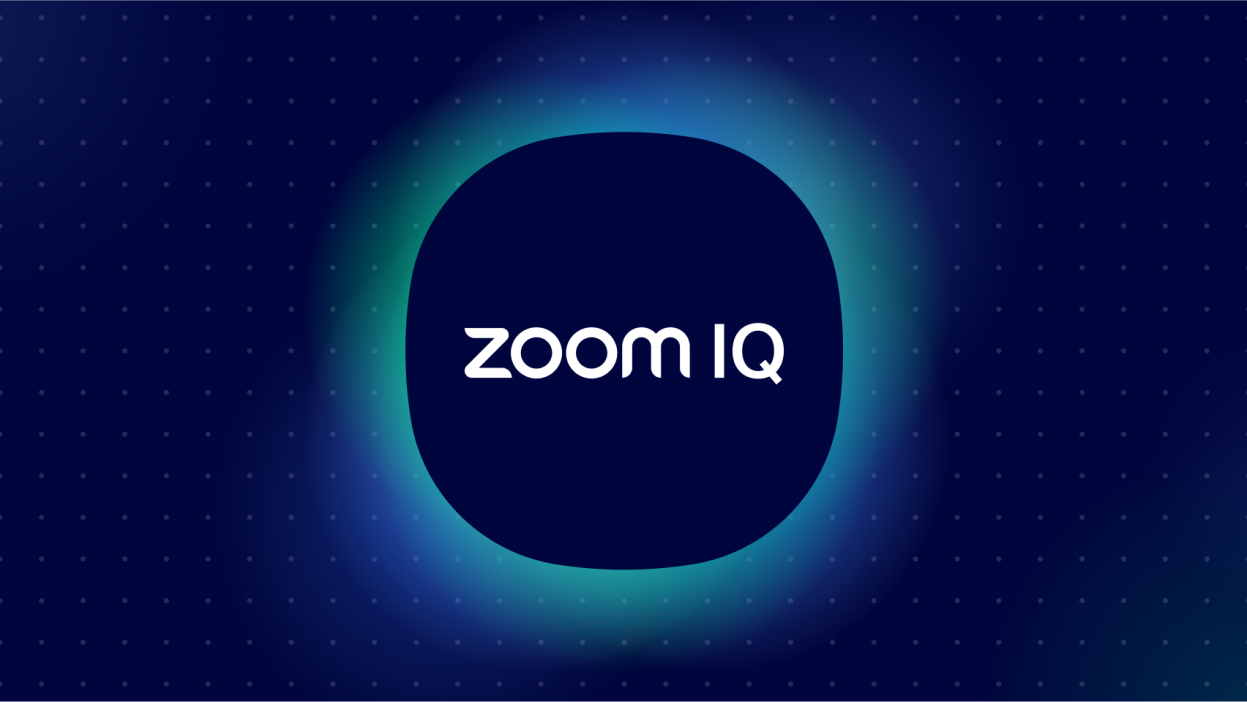
Zoom IQ Logo, Zooms neue KI-Suite
Hauptmerkmale von Zooms KI-Begleiter:
- Besprechungszusammenfassung: AI Companion kann Zoom-Besprechungen automatisch zusammenfassen und dabei wichtige Erkenntnisse, Aktionspunkte und nächste Schritte hervorheben. Dies spart den Nutzern Zeit und hilft ihnen, den Überblick über ihre Arbeit zu behalten.
- Chat-Zusammenfassung: AI Companion kann auch Zoom-Chat-Konversationen zusammenfassen und den Nutzern so eine schnelle und einfache Möglichkeit bieten, versäumte Diskussionen nachzuholen.
- Unterstützung beim Brainstorming: AI Companion kann Nutzern helfen, Ideen zu generieren und Lösungen für Probleme zu brainstormen, indem er relevante Themen, Formulierungen und Fragen vorschlägt.
- Aufgabenautomatisierung: AI Companion kann eine Vielzahl von Aufgaben automatisieren, wie z. B. die Planung von Besprechungen, die Einreichung von Support-Tickets und die Recherche von Informationen. Dies gibt den Nutzern Zeit, sich auf wichtigere Dinge zu konzentrieren.
- Präsentationscoaching: AI Companion kann Nutzern in Echtzeit Feedback zu ihren Kommunikations- und Präsentationsfähigkeiten geben und ihnen so helfen, ihre Vorträge zu verbessern und einen positiveren Eindruck zu hinterlassen.
Zusätzlich zu diesen Hauptmerkmalen wird Zooms KI-Begleiter ständig mit neuen Funktionen aktualisiert. In naher Zukunft wird AI Companion beispielsweise in der Lage sein:
- Automatische Erkennung der Besprechungsabsicht in Chat-Nachrichten und Anzeige einer Planungs-Schaltfläche, um den Planungsprozess zu rationalisieren.
- Nutzern personalisierte E-Mail-Vorschläge unterbreiten und schnelle Antworten entwerfen.
- Erstellung neuer Bilder auf der Grundlage bestehender Inhalte in Zoom Whiteboard.
- Den Nutzern Echtzeit-Feedback zu ihrer Präsenz und Leistung geben, zusammen mit KI-gesteuertem Coaching zu Konversations- und Präsentationsfähigkeiten.
Zooms KI-Begleiter ist ein leistungsstarkes und vielseitiges Werkzeug, das das Potenzial hat, die Art und Weise, wie wir arbeiten, zu revolutionieren. Er kann uns helfen, Zeit zu sparen, die Produktivität zu steigern, effektiver zusammenzuarbeiten und bessere Ergebnisse zu erzielen. Da sich KI immer weiterentwickelt und ausgefeilter wird, können wir davon ausgehen, dass Zooms KI-Begleiter noch leistungsstärker und unverzichtbarer wird.
Zoom AI Companion kann Ihnen helfen:
- E-Mails und Chat-Nachrichten entwerfen: AI Companion kann Ihnen helfen, E-Mails und Chat-Nachrichten schneller und effizienter zu entwerfen. Er kann relevante Inhalte basierend auf dem Kontext der Konversation vorschlagen, und er kann Ihnen sogar helfen, Nachrichten in andere Sprachen zu übersetzen.
- Meetings und Chat-Threads zusammenfassen: AI Companion kann Meetings und Chat-Threads automatisch zusammenfassen, was Ihnen Zeit spart und Ihnen hilft, den Überblick über Ihre Arbeit zu behalten. Er kann auch wichtige Erkenntnisse, Aktionspunkte und nächste Schritte identifizieren.
- Brainstorming-Sitzungen unterhaltsamer und produktiver gestalten: AI Companion kann Ihnen helfen, Ideen zu generieren und Lösungen für Probleme effektiver zu brainstormen. Er kann relevante Themen, Formulierungen und Fragen vorschlagen, und er kann Ihnen sogar helfen, Ihre Ideen zu visualisieren.
Zoom verfolgt einen einzigartigen föderierten und verantwortungsvollen Ansatz für KI. Das bedeutet, dass AI Companion mit einem massiven Datensatz aus Text und Code trainiert wird, der nicht Zoom gehört. Dies stellt sicher, dass AI Companion immer lernt und sich verbessert und dass er nicht auf ein bestimmtes Produkt oder eine bestimmte Dienstleistung ausgerichtet ist.
Zoom setzt sich auch für verantwortungsvolle KI ein. Es werden keine Audio-, Video-, Chat-, Bildschirmfreigabe-, Anhänge oder andere Kommunikationsinhalte von Kunden zum Trainieren von KI-Modellen verwendet. Das bedeutet, dass Sie sicher sein können, dass Ihre Daten immer sicher sind.
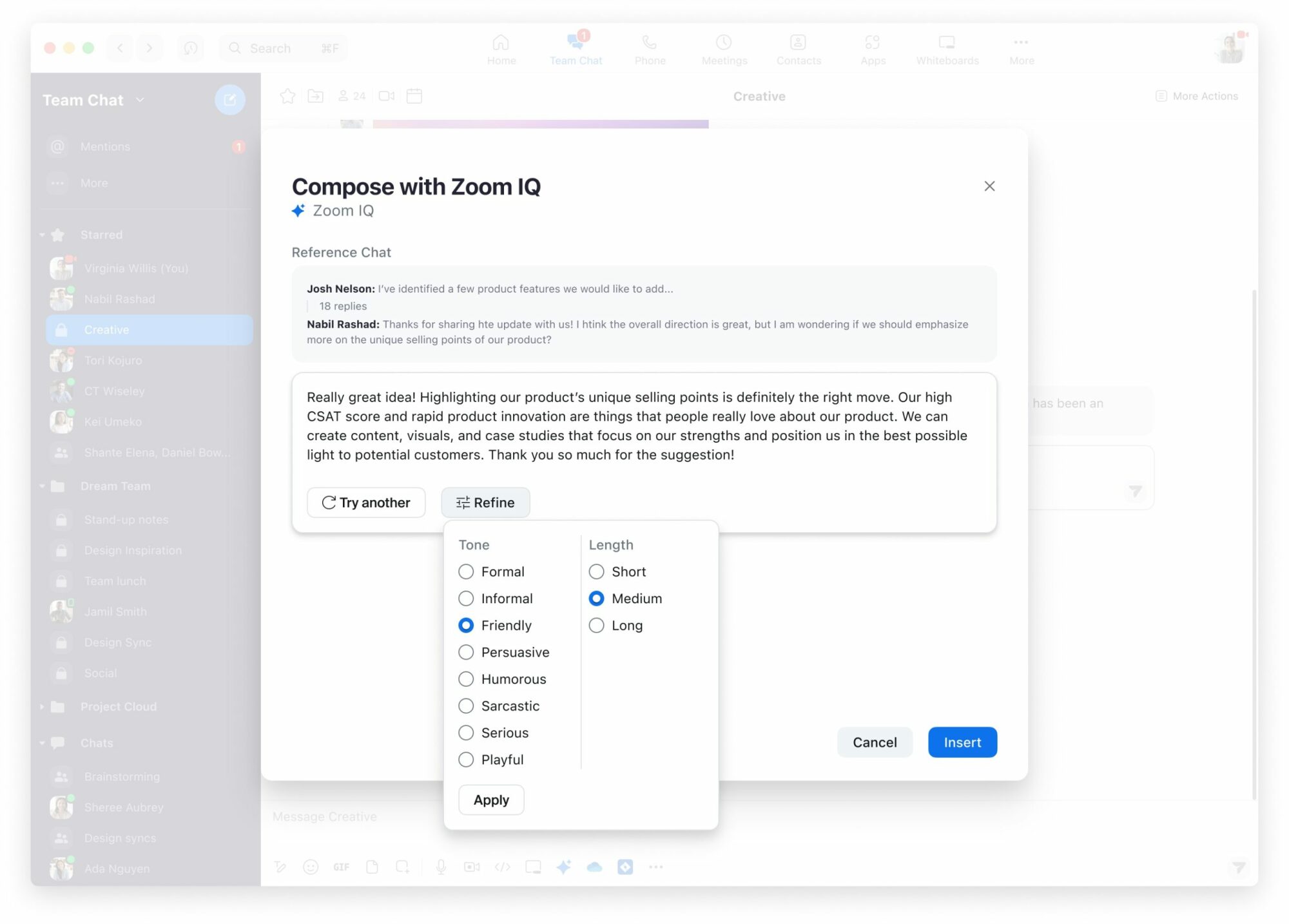
Komponieren mit Zoom IQ
AI Companion bietet eine Vielzahl weiterer Funktionen
- Transkription: AI Companion kann Meetings transkribieren, was es einfach macht, Transkripte für Ihr Team oder für Ihre eigene Referenz zu erstellen.
- Einblicke: AI Companion kann Einblicke aus Meetings extrahieren, wie z. B. wichtige Entscheidungen, Aktionspunkte und Stimmungsanalysen. Diese Informationen können verwendet werden, um Ihre Meetings zu verbessern und Ihr Team produktiver zu machen.
- Stimmungsanalyse: AI Companion kann Stimmungsanalysen durchführen in Meetings, Chat-Threads und anderen Formen der Kommunikation. Diese Informationen können verwendet werden, um zu verstehen, wie sich die Menschen fühlen, und um potenzielle Probleme zu identifizieren.
- Kalender- und Videokonferenz-Integration: AI Companion lässt sich einfach mit Ihrem Kalender und Ihrer Videokonferenz-Software verbinden. Es funktioniert mit Zoom und Google Meet und ist mit anderen gängigen Plattformen kompatibel.
Zoom AI Companion ist ein leistungsstarker und vielseitiger KI-Assistent, der Ihnen helfen kann, produktiver, kollaborativer und kompetenter zu sein. Es ist ein großartiges Werkzeug für Einzelpersonen, Teams und Unternehmen aller Größen.
Aber es ist nicht alles rosig mit Zoom AI Companion, wir haben einige Einschränkungen und Nachteile festgestellt:
Einschränkungen des Zoom KI-Assistenten
- AI Companion ist nur mit einem kostenpflichtigen Zoom-Konto verfügbar. Das bedeutet, dass Nutzer des kostenlosen Zoom-Plans diese Funktion nicht nutzen können.
- Einige Nutzer möchten KI während ihrer Meetings möglicherweise nicht verwenden. Einige Leute haben vielleicht das Gefühl, dass KI nicht gut zu ihrem Arbeitsumfeld oder zu der Art von Meetings passt, die sie haben. Andere fühlen sich mit der Idee, KI in einem professionellen Umfeld einzusetzen, einfach unwohl.
- Einige Nutzer trauen KI möglicherweise nicht zu, ihre Daten sicher zu verarbeiten. KI-Systeme werden mit großen Datenmengen trainiert, und einige Nutzer sind möglicherweise besorgt darüber, wie ihre Daten verwendet und geschützt werden.
- AI Companion ist möglicherweise nicht in der Lage, alle Meetings genau zu transkribieren. KI-Transkriptionssysteme können von einer Vielzahl von Faktoren beeinflusst werden, wie z. B. Hintergrundgeräuschen, Akzenten und Sprachmustern. Das bedeutet, dass AI Companion möglicherweise nicht in der Lage ist, alle Meetings genau zu transkribieren, insbesondere wenn sie laut sind oder Teilnehmer mit starken Akzenten haben.
- Einige Nutzer ziehen es möglicherweise vor, ihre eigenen Notizen zu machen, anstatt sich auf KI zu verlassen. Einige Leute ziehen es möglicherweise einfach vor, während Meetings ihre eigenen Notizen zu machen, damit sie mehr Kontrolle über den Prozess haben und sicher sein können, dass ihre Notizen korrekt sind.
- AI Companion ist möglicherweise nicht in der Lage, alle Akzente oder Sprachmuster zu verstehen. Wie oben erwähnt, können KI-Transkriptionssysteme von Akzenten und Sprachmustern beeinflusst werden. Das bedeutet, dass AI Companion möglicherweise nicht in der Lage ist, alle Teilnehmer an einem Meeting zu verstehen, insbesondere wenn sie starke Akzente haben oder wenn sie schnell oder undeutlich sprechen.
- Einige Nutzer empfinden die AI Companion-Funktion während Meetings möglicherweise als störend. AI Companion ist ein ständig laufender Prozess, daher kann es für einige Nutzer störend sein, ihn während eines Meetings im Hintergrund laufen zu lassen.
- AI Companion ist möglicherweise nicht in der Lage, alle Meetings genau zusammenzufassen. KI-Zusammenfassungssysteme können von einer Vielzahl von Faktoren beeinflusst werden, wie z. B. der Länge und Komplexität des Meetings, der Qualität der Transkription und dem spezifischen Zusammenfassungsalgorithmus, der verwendet wird. Das bedeutet, dass AI Companion möglicherweise nicht in der Lage ist, alle Meetings genau zusammenzufassen, insbesondere wenn sie lang, komplex sind oder viel Fachjargon enthalten.
- Einige Nutzer möchten sich möglicherweise nicht auf KI verlassen, um Support-Tickets einzureichen oder Informationen zu recherchieren. Einige Leute ziehen es möglicherweise einfach vor, diese Aufgaben selbst zu erledigen, damit sie mehr Kontrolle über den Prozess haben und sicher sein können, dass sie die bestmöglichen Ergebnisse erzielen.
- AI Companion ist möglicherweise nicht in der Lage, Einblicke oder Stimmungsanalysen aus allen Meetings genau zu extrahieren. KI-Stimmungsanalysesysteme können von einer Vielzahl von Faktoren beeinflusst werden, wie z. B. dem Tonfall der Teilnehmer, dem Kontext der Konversation und dem spezifischen Algorithmus, der verwendet wird. Das bedeutet, dass AI Companion möglicherweise nicht in der Lage ist, Einblicke oder Stimmungsanalysen aus allen Meetings genau zu extrahieren, insbesondere wenn sie komplex sind oder viel Fachjargon enthalten.
- Einige Nutzer möchten KI möglicherweise nicht zur Produktivitäts- oder Kompetenzsteigerung einsetzen. Einige Leute ziehen es möglicherweise einfach vor, traditionelle Methoden zu verwenden, um ihre Produktivität und Fähigkeiten zu verbessern. Andere sind möglicherweise besorgt über die potenziellen negativen Folgen des Einsatzes von KI, wie z. B. Arbeitsplatzverluste oder verstärkte Überwachung.
- AI Companion ist möglicherweise nicht in der Lage, sich in alle Videokonferenz-Software zu integrieren. AI Companion ist derzeit nur mit Zoom und Google Meet kompatibel. Nutzer anderer Videokonferenz-Software können diese Funktion nicht nutzen.
- Einige Nutzer möchten KI möglicherweise nicht für die Zusammenarbeit oder die Themenverfolgung einsetzen. Einige Leute ziehen es möglicherweise einfach vor, manuell mit ihren Kollegen zusammenzuarbeiten und Themen zu verfolgen. Andere sind möglicherweise besorgt über das Potenzial von KI, die Zusammenarbeit zu beeinflussen oder Themen auf eine Weise zu verfolgen, die nicht mit ihren Werten übereinstimmt.
- AI Companion ist möglicherweise nicht in der Lage, wichtige Entscheidungen genau zu identifizieren oder Aktionspunkte für alle Meetings zu erstellen. KI-Systeme zur Entscheidungsidentifizierung und Aktionspunktserstellung können von einer Vielzahl von Faktoren beeinflusst werden, wie z. B. der Komplexität des Meetings, der Qualität der Transkription und dem spezifischen Algorithmus, der verwendet wird. Das bedeutet, dass AI Companion möglicherweise nicht in der Lage ist, wichtige Entscheidungen genau zu identifizieren oder Aktionspunkte für alle Meetings zu erstellen, insbesondere wenn sie komplex sind oder viel Fachjargon enthalten.
- Einige Nutzer möchten KI möglicherweise nicht für die Erstellung von Notizen während Meetings einsetzen. Einige Leute ziehen es möglicherweise einfach vor, während Meetings ihre eigenen Notizen zu machen, damit sie mehr Kontrolle über den Prozess haben und sicher sein können, dass ihre Notizen korrekt sind.
- AI Companion ist möglicherweise nicht in der Lage, Unterbrechungen oder überlappende Sprache während Meetings genau zu verarbeiten. KI-Transkriptionssysteme können von Unterbrechungen und überlappender Sprache beeinflusst werden. Das bedeutet, dass AI Companion möglicherweise nicht in der Lage ist, alle Meetings genau zu transkribieren, insbesondere wenn sie laut sind oder viele Unterbrechungen beinhalten.
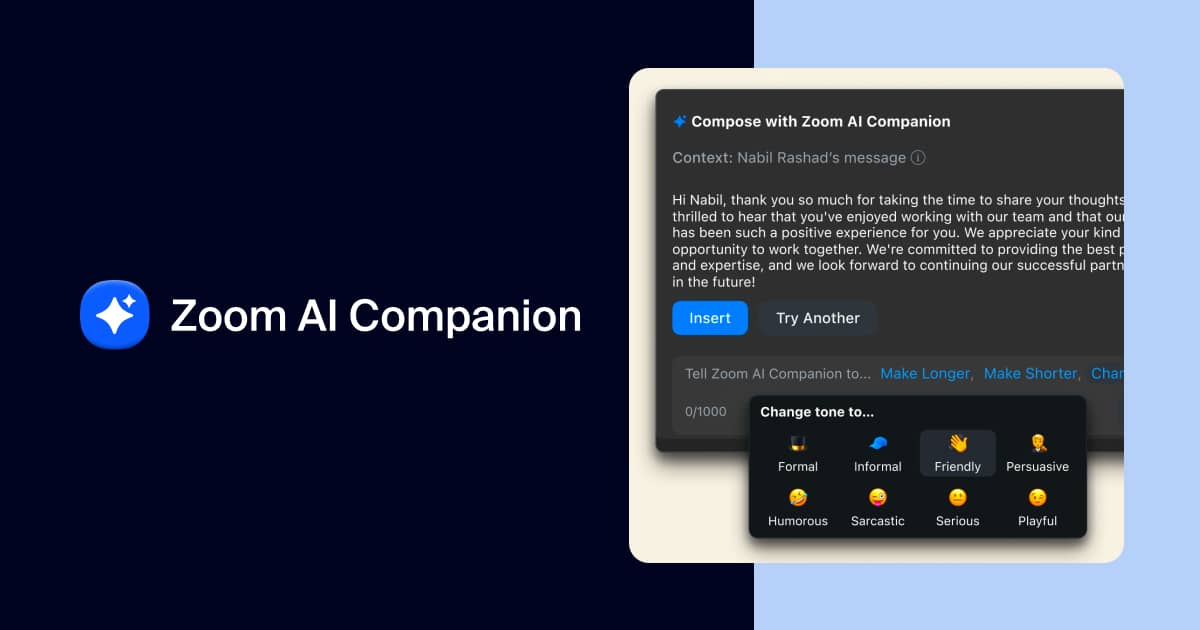
Sie können Follow-ups innerhalb von Zoom schreiben
Auf der Suche nach einer Alternative zu Zoom AI Companion?
Sind irgendwelche dieser Einschränkungen ein Deal-Killer?
ScreenApp ist ein leistungsstarkes Tool zur Videoaufzeichnung und -transkription, das eine Reihe von Vorteilen gegenüber Zoom AI Companion bietet. Es ist plattformübergreifend kompatibel, was bedeutet, dass es mit jeder Videokonferenzsoftware verwendet werden kann, nicht nur mit Zoom.
Wer benutzt Meet oder Teams?
ScreenApp speichert außerdem alles zentral in der Cloud, so dass Sie von überall aus einfach auf Ihre Meeting-Aufzeichnungen und Notizen zugreifen können. Darüber hinaus bietet ScreenApp schnellere und genauere Transkriptionen mit ChatGPT-Funktionalität, was eine größere Vielseitigkeit ermöglicht. Schließlich können Sie mit ScreenApp jedes beliebige Video aufzeichnen oder hochladen, nicht nur Zoom-Meetings.
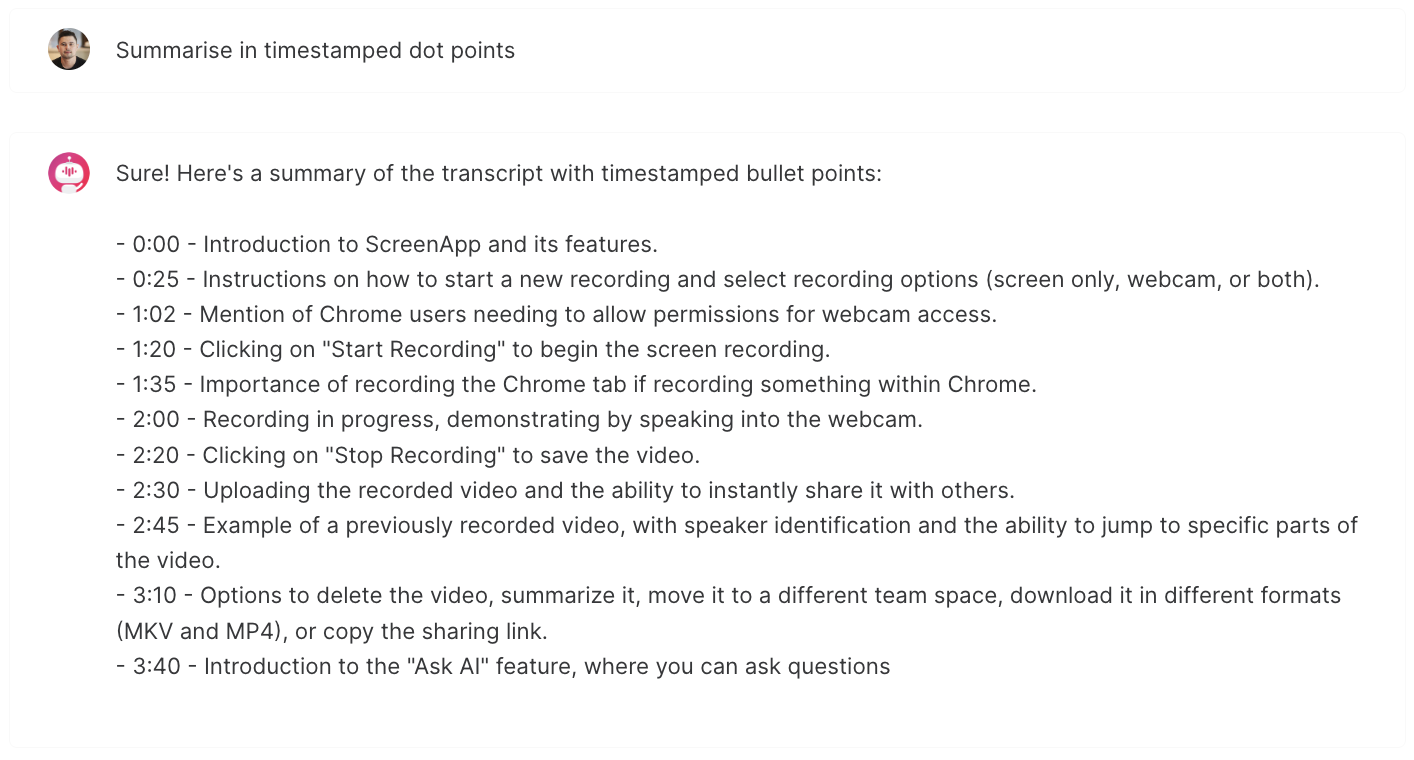
Beschleunigen und vereinfachen Sie Zusammenfassungen mit ScreenApp
Das plattformübergreifende Videoaufzeichnungs- und Transkriptions-Tool, das Zoom AI Companion übertrifft
Plattformübergreifende Kompatibilität: ScreenApp kann mit jeder Videokonferenzsoftware verwendet werden, nicht nur mit Zoom. Dies macht es zu einem vielseitigeren Tool für Nutzer, die Meetings aus verschiedenen Quellen aufzeichnen und transkribieren müssen.
Cloud-Speicher: ScreenApp speichert alles zentral in der Cloud, so dass Sie von überall aus einfach auf Ihre Meeting-Aufzeichnungen und Notizen zugreifen können. Dies steht im Gegensatz zu Zoom AI Companion, das Meeting-Aufzeichnungen lokal auf Ihrem Gerät speichert.
Schnellere und genauere Transkriptionen: ScreenApp verwendet ChatGPT, um schnellere und genauere Transkriptionen Ihrer Meetings zu erstellen. ChatGPT ist ein hochmodernes KI-Sprachmodell, das auf einem riesigen Datensatz aus Text und Code trainiert wurde. Dies macht es besser geeignet, komplexe und technische Konversationen zu transkribieren als die KI-Transkriptionssysteme, die von Zoom AI Companion verwendet werden.
ChatGPT-Funktionalität: Mit der ChatGPT-Funktionalität von ScreenApp können Sie mehr tun, als nur Ihre Meetings zu transkribieren. Sie können es auch verwenden, um Zusammenfassungen zu erstellen, Sprachen zu übersetzen, verschiedene Arten von kreativen Inhalten zu schreiben und Ihre Fragen auf informative Weise zu beantworten. Dies macht ScreenApp zu einem vielseitigeren Tool für Nutzer, die mehr tun müssen, als nur ihre Meetings zu transkribieren.
Beliebiges Video aufnehmen oder hochladen: Mit ScreenApp können Sie jedes beliebige Video aufnehmen oder hochladen, nicht nur Zoom-Meetings. Das bedeutet, dass Sie ScreenApp verwenden können, um beliebige Videoinhalte zu transkribieren, einschließlich Vorlesungen, Podcasts und Webinare.
.webp)
Chatten Sie mit jedem Video, nicht nur mit Zoom-Meetings

